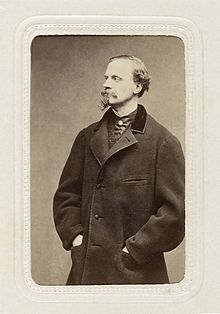Amédée de Noé
This article relies largely or entirely on a single source. (April 2020) |


Charles Amédée de Noé, known as Cham (26 January 1818 – 6 September 1879), was a French caricaturist and lithographer.
He was born in Paris and raised by a family who wished for him to attend a polytechnic school. He instead attended painting workshops hosted by Nicolas Charlet and Paul Delaroche and began work as a cartoonist. He eventually took up the pseudonym of "Cham".
In 1839, he published his first book, Monsieur Lajaunisse, which began a career that would span 40,000 drawings. In 1843, he began to have his illustrations published in newspapers like Le Charivari, a publication where he was on staff for thirty years. Later works included Proudhon en voyage and Histoire comique de l'Assemblée Nationale. He wrote a number of comic plays towards the end of his life. He died in Paris in 1879.
Depiction of people of colour[edit]
Cham was known for his racist portrayal of French people of colour.[1] He was specifically targeting black women and drew them as animal-like, stereotyped caricatures. One example is his caricature of Alexander Dumas crossed dressed like a wet nurse, which was a popular profession for black women in the post-slavery era in 19th-century France.[1] In a different caricature, he referred to the milk of a black wet-nurse as "black shoe polish".[1]
References[edit]
External links[edit]
![]() Media related to Amédée de Noé at Wikimedia Commons
Media related to Amédée de Noé at Wikimedia Commons
- Lambiek Comiclopedia article.
- Les folies de la Commune, a fully digitized work by "Cham"
- Blog
